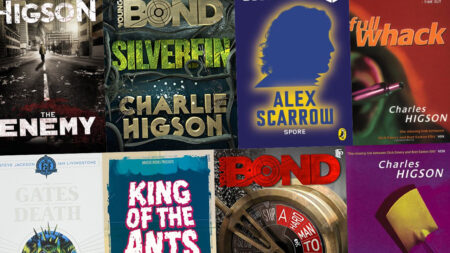Haruki Murakami Books in Order (1Q84, Norwegian Wood, Drive My Car)
All of Haruki Murakami’s books in order!
Who is Haruki Murakami?
Haruki Murakami is a bestselling award-winning Japanese writer whose work has been translated into 50 languages. He is known for exploring genres like science fiction, fantasy, and crime fiction, and has become known for its use of magical realist elements.
Inspired by authors like Raymond Chandler, Kurt Vonnegut, and Richard Brautigan, Haruki Murakami’s most notable works include the novels Norwegian Wood, The Wind-Up Bird Chronicle, Kafka on the Shore, and 1Q84.
How to read Haruki Murakami’s Books in Order?
- Hear the Wind Sing/Pinball, 1973 (1979-80) – In the spring of 1978, a young Haruki Murakami sat down at his kitchen table and began to write. The result: two remarkable short novels-Hear the Wind Sing and Pinball, 1973. These powerful, at times surreal, works about two young men coming of age-the unnamed narrator and his friend the Rat-are stories of loneliness, obsession, and eroticism. They bear all the hallmarks of Murakami’s later books, and form the first two-thirds, with A Wild Sheep Chase, of the trilogy of the Rat.
- A Wild Sheep Chase (1982) – An advertising executive receives a postcard from a friend and casually appropriates the image for an advertisement. What he doesn’t realize is that included in the scene is a mutant sheep with a star on its back, and in using this photo he has unwittingly captured the attention of a man who offers a menacing ultimatum: find the sheep or face dire consequences. Thus begins a surreal and elaborate quest that takes readers from Tokyo to the remote mountains of northern Japan, where the unnamed protagonist has a surprising confrontation with his demons.
- Hard-Boiled Wonderland and the End of the World (1985) – Across two parallel narratives, Murakami draws listeners into a mind-bending universe in which Lauren Bacall, Bob Dylan, a split-brained data processor, a deranged scientist, his shockingly undemure granddaughter, and various thugs, librarians, and subterranean monsters collide to dazzling effect. What emerges is a novel that is at once hilariously funny and a deeply serious meditation on the nature and uses of the mind.
- Norwegian Wood (1987) – Toru, a serious young college student in Tokyo, is devoted to Naoko, a beautiful and introspective young woman, but their mutual passion is marked by the tragic death of their best friend years before. As Naoko retreats further into her own world, Toru finds himself drawn to a fiercely independent and sexually liberated young woman.
- Dance Dance Dance (1988) – As Murakami’s nameless protagonist searches for a mysteriously vanished girlfriend, he is plunged into a wind tunnel of sexual violence and metaphysical dread. In this propulsive novel, featuring a shabby but oracular Sheep Man, one of the most idiosyncratically brilliant writers at work today fuses together science fiction, the hardboiled thriller, and white-hot satire.
- South of the Border, West of the Sun (1992) – Hajime has arrived at middle age with a loving family and an enviable career, yet he feels incomplete. When a childhood friend, now a beautiful woman, shows up with a secret from which she is unable to escape, the fault lines of doubt in Hajime’s quotidian existence begin to give way. Rich, mysterious, and quietly dazzling, in South of the Border, West of the Sun the simple arc of one man’s life becomes the exquisite literary terrain of Murakami’s remarkable genius.
- The Wind-Up Bird Chronicle (1994-95) – In a Tokyo suburb, a young man named Toru Okada searches for his wife’s missing cat-and then for his wife as well-in a netherworld beneath the city’s placid surface. As these searches intersect, he encounters a bizarre group of allies and antagonists. Gripping, prophetic, and suffused with comedy and menace, this is an astonishingly imaginative detective story, an account of a disintegrating marriage, and an excavation of the buried secrets from Japan’s forgotten campaign in Manchuria during World War II.
- Sputnik Sweetheart (1995) – K is madly in love with his best friend, Sumire, but her devotion to a writerly life precludes her from any personal commitments. At least, that is, until she meets an older woman to whom she finds herself irresistibly drawn. When Sumire disappears from an island off the coast of Greece, K is solicited to join the search party-and finds himself drawn back into her world and beset by ominous visions.
- Kafka on the Shore (2002) – Here we meet a teenage boy, Kafka Tamura, who is on the run, and Nakata, an aging simpleton who is drawn to Kafka for reasons that he cannot fathom. As their paths converge, acclaimed author Haruki Murakami enfolds readers in a world where cats talk, fish fall from the sky, and spirits slip out of their bodies to make love or commit murder, in what is a truly remarkable journey.
- After Dark (2004) – Nineteen-year-old Mari is waiting out the night in an anonymous Denny’s when she meets a young man who insists he knows her older sister, thus setting her on an odyssey through the sleeping city. In the space of a single night, the lives of a diverse cast of Tokyo residents-models, prostitutes, mobsters, and musicians-collide in a world suspended between fantasy and reality. Utterly enchanting and infused with surrealism, After Dark is a thrilling account of the magical hours separating midnight from dawn.
- 1Q84 (2009-10) – The year is 1984 and the city is Tokyo. A young woman named Aomame follows a taxi driver’s enigmatic suggestion and begins to notice puzzling discrepancies in the world around her. She has entered, she realizes, a parallel existence, which she calls 1Q84 – “Q” is for “question mark”. A world that bears a question. Meanwhile, an aspiring writer named Tengo takes on a suspect ghostwriting project. He becomes so wrapped up with the work and its unusual author that, soon, his previously placid life begins to come unraveled.
- Colorless Tsukuru Tazaki and His Years of Pilgrimage (2013) – Tsukuru Tazaki had four best friends at school. By chance, all of their names contained a color. The two boys were called Akamatsu, meaning ‘red pine’, and Oumi, ‘blue sea’, while the girls’ names were Shirane, ‘white root’, and Kurono, ‘black field’. Tazaki was the only last name with no color in it.
- Killing Commendatore (2017) – When a thirty-something portrait painter is abandoned by his wife, he secludes himself in the mountain home of a world famous artist. One day, the young painter hears a noise from the attic, and upon investigation, he discovers a previously unseen painting. By unearthing this hidden work of art, he unintentionally opens a circle of mysterious circumstances; and to close it, he must undertake a perilous journey into a netherworld.
- Novelist as a Vocation (Non Fiction, 2022) – Haruki Murakami shares with readers his thoughts on the role of the novel in our society; his own origins as a writer; and his musings on the sparks of creativity that inspire other writers, artists, and musicians. Here are the personal details of a life devoted to craft: the initial moment at a Yakult Swallows baseball game, when he suddenly knew he could write a novel; the importance of memory, what he calls a writer’s “mental chest of drawers”; the necessity of loneliness, patience, and his daily running routine; the seminal role a carrier pigeon played in his career.
Haruki Murakami’s collections of short stories
- The Elephant Vanishes (2005) – In these stories, a man sees his favorite elephant vanish into thin air; a newlywed couple suffers attacks of hunger that drive them to hold up a McDonald’s in the middle of the night; and a young woman discovers that she has become irresistible to a little green monster who burrows up through her backyard. By turns haunting and hilarious, in The Elephant Vanishes Murakami crosses the border between separate realities-and comes back bearing remarkable treasures.
- After the Quake (2006) – An electronics salesman who has been deserted by his wife agrees to deliver an enigmatic package- and is rewarded with a glimpse of his true nature. A man who views himself as the son of God pursues a stranger who may be his human father. A mild-mannered collection agent receives a visit from a giant talking frog who enlists his help in saving Tokyo from destruction. The six stories in this collection come from the deep and mysterious place where the human meets the inhuman-and are further proof that Murakami is one of the most visionary writers at work today.
- Blind Willow, Sleeping Woman (2006) – Here are animated crows, a criminal monkey, and an ice man, as well as the dreams that shape us and the things we might wish for. From the surreal to the mundane, these stories exhibit Murakami’s ability to transform the full range of human experience in ways that are instructive, surprising, and entertaining.
- Men Without Women (2014) – Across seven tales (including “Drive My Car”), Haruki Murakami brings his powers of observation to bear on the lives of men who, in their own ways, find themselves alone. Here are lovesick doctors, students, ex-boyfriends, actors, bartenders, and even Kafka’s Gregor Samsa, brought together to tell stories that speak to us all. In Men Without Women Murakami has crafted another contemporary classic, marked by the same wry humor and pathos that have defined his entire body of work.
- First Person Singular (2020) – The eight stories in this new book are all told in the first person by a classic Murakami narrator. From memories of youth, meditations on music, and an ardent love of baseball, to dreamlike scenarios and invented jazz albums, together these stories challenge the boundaries between our minds and the exterior world. Occasionally, a narrator may or may not be Murakami himself. Is it a memoir or fiction? The reader decides.
If you like Haruki Murakami’s books, you may also want to see our guide to Kazuo Ishiguro’s books. And don’t forget to bookmark this guide!
























